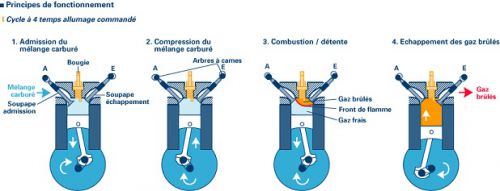thermal engine

Definition
The engine indicates the heart of a standard automobile, that is powered by gasoline or diesel. This term has been used most often since the electric car, to mark the difference between the two.
Most cars on the market today operate with a combustion engine. Some of them, like the Toyota Prius, also house a power unit. Finally, cars using 100% of this energy are still rare. In France, the most common thermal blocks are the HDi and dCi diesels.
It is called a heat engine for a non-electric car because it produces its energy by burning at very high temperatures (combustion or explosion phase) the fuel it has. This is the mode of operation of most transport vehicles. The flue gases are then released via the exhaust outlet.
Current state
Most cars on the market today operate with a combustion engine. Some of them, like the Toyota Prius, also house a power unit. Finally, cars using 100% of this energy are still rare. In France, the most common thermal blocks are the HDi and dCi diesels.
Evolution
The construction of the first heat engine dates back to the 19th century, a few years before the launch of the first cars during the industrial revolution. Since then, a lot of evolutions and alternatives have appeared: two- or four-stroke engines, with or without valves, with three, four, six, eight or twelve cylinders ... Today, it is often pointed as the first cause of pollution in urban areas, where the system of restricted traffic Anecdote Because it engages a fast and powerful combustion of chemical elements during its operation, the heat engine is naturally polluting: it emits a noise more or less strong and rejects various carbon particles in the air. In France, its level of toxicity is determined by calculating its CO2 emission rate. Related Info Bioethanol is the fuel most used on gasoline engines.
The construction of the first heat engine dates back to the 19th century, a few years before the launch of the first cars during the industrial revolution. Since then, a lot of evolutions and alternatives have appeared: two- or four-stroke engines, with or without valves, with three, four, six, eight or twelve cylinders ... Today, it is often pointed as the first cause of pollution in urban areas, where the system of restricted traffic Anecdote Because it engages a fast and powerful combustion of chemical elements during its operation, the heat engine is naturally polluting: it emits a noise more or less strong and rejects various carbon particles in the air. In France, its level of toxicity is determined by calculating its CO2 emission rate. Related Info Bioethanol is the fuel most used on gasoline engines.




Enregistrer un commentaire